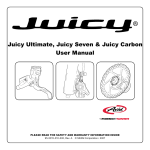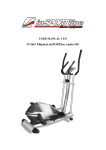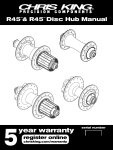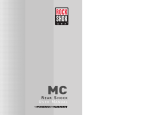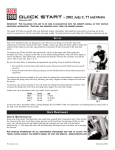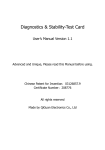Download Dual Air Spring Tuning Guide 2001 - 2012
Transcript
Dual Air Spring Tuning Guide 2001 - 2012 GEN.0000000004160 Rev A Copyright ©2011 SRAM, LLC SAFETY FIRST! We care about YOU. Please, always wear your safety glasses and protective gloves when servicing RockShox products. Protect yourself! Wear your safety gear! 2 INTRODUCTION Dual Air technology provides the rider with a tremendous range of setup and tuning possibilities for their suspension fork, using air positive and air negative springs. Positive springs support the weight of the bike and the rider. Negative springs counteracts friction and breakaway. This guide will show you how to: • Determine the amount of fork travel. • Perform initial spring setup for your approximate rider weight. • Use sag to perform a more detailed spring setup for your exact rider weight. • Use performance tuning to set the fork to be “XC (Cross Country)” fast and efficient, or “All Mountain” smooth and supple. ITEMS YOU WILL NEED FOR TUNING • Shock pump • Small hex wrench • Clean, lint-free rag • A wall or a strong, trustworthy friend SHOCK PUMP USE When the suspension pump is attached to the fork, a small amount of air will move from the fork into the pump. This is why you can pump the fork up to a certain pressure, then remove the pump, re-attach it, and find a lower reading. This is normal and does not indicate that the fork is leaking air. In addition, when you remove the pump from the fork, you will hear a hissing sound. This is pressurized air escaping from the pump, not the fork. This is also normal. NOTIC E Do not use an air compressor to adjust the air spring pressure in your fork. Air compressors may cause damage to the fork. SAG Sag is the amount the fork compresses when you are sitting on your bike while wearing your normal riding gear (hydration pack, helmet, clothing, etc.). It is important to tune the sag measurement of your fork because proper sag enhances the ability of the front wheel to follow the changing contours of the terrain as you ride. LOCKOUT If the fork is equipped with a lockout, turn the lockout, located at the top of the drive side fork leg, to the ‘Unlocked’ position. 3 DETERMINE FORK TRAVEL Some RockShox forks have travel gradients printed on the upper tubes of the fork. If your fork has travel gradients, compare the top of the dust wiper to the travel gradients to determine the amount of travel the fork has, then move on to the next section, Initial Setup. If your fork does not have travel gradients, use the following steps to determine how much travel your fork has. 1 Remove the caps from the air valves located at the top and bottom of the non-drive side fork leg. 2 While holding a rag over the front brake rotor (if applicable), use a small hex wrench to depress the Schrader valve at the bottom of the fork leg to release all of the pressure from the negative spring. 4 3 Use the small hex wrench to depress the Schrader valve at the top of the fork leg to release all of the air pressure from the positive air spring. 4 Some RockShox forks are equipped with a sag indicator o-ring. If your fork does not have an o-ring, fasten a zip tie around one of the upper tubes. Tighten the zip tie so that it stays in place but can slide along the upper tube easily. Slide the o-ring or zip tie down against the wiper seal. You will use this zip tie later when setting sag. 5 5 Compress the fork until it bottoms out. 6 Thread a shock pump onto the air valve at the top of the non-driveside fork leg. Pressurize the fork to 20 psi. This is just enough pressure extend the fork to it’s full length). 7 Measure the distance from the top of the dust wiper to the bottom of the o-ring or zip tie. Add 5-15 mm to this measurement. This is your approximate fork travel. Be careful when compressing the fork; a fork without air pressure will compress very easily. Once you’ve determined the fork travel, cut the zip tie and remove it from the fork 6 QUICK SETUP Some RockShox forks have an air pressure chart printed on the back of the non-driveside fork leg, or in the fork User Manual. If this information is not available, skip to the next section, Setup Using Sag. The following steps will show you how to perform a quick spring setup using the air pressure chart. 1 Remove the caps from the air valves located at the top and bottom of the non-drive side fork leg. 2 While holding a rag over the front brake rotor (if applicable), use a small hex wrench to depress the Schrader valve at the bottom of the fork leg to release all of the air pressure from the negative spring. Holding a rag over the rotor will prevent any fluid that escapes from the fork leg from contaminating the rotor. 3 7 Thread a shock pump onto the air valve at the top of the non-drive side fork leg. Use the air pressure chart to determine the appropriate positive pressure for your weight (including riding gear). Use the pump to adjust the positive spring to this pressure. 4 Once you have adjusted the positive spring pressure, remove the pump from the fork, then thread it onto the negative spring air valve, located at the bottom of the fork leg. Inflate the negative spring to the same pressure as the positive spring. Remove the pump from the negative spring air valve. At this point, the fork is set up to your rider weight range. You can reinstall the air valve caps and go for a ride. However, if you want to dial the fork in to your exact rider weight, continue on to the next section, Setup Using Sag. 8 SETUP USING SAG The following steps will show you how to set up the fork to your rider weight using sag. 1 Remove the caps from the air valves located at the top and bottom of the non-drive side fork leg. 2 If the fork has an external travel adjust feature, adjust the fork to its maximum travel setting. 3 Put on all of your normal riding gear. Sit on the bike and brace yourself upright, or have a friend securely hold the bike upright while you sit on it. 9 4 Compress the fork a couple of times, then gently sit down on the saddle. 5 While remaining seated, slide the indicator o-ring or zip tie down against the wiper seal. Avoid compressing the suspension after the o-ring/zip tie is in place. 10 6 Carefully step off the bike. If your fork has sag gradients, compare the location of the sag indicator o-ring or zip tie against the sag gradients. This is your sag. If the fork does not have sag gradients, measure the distance from the top of the wiper seal to the sag o-ring or zip tie. Use this measurement and the travel of the fork to calculate sag. The ideal amount of sag is between 10-40% of the travel of the fork. Fork travel (mm) Sag percentage 7 10% 20% 30% 40% 60 6 12 18 24 80 8 16 24 32 100 10 20 30 40 120 12 24 36 48 140 14 28 42 56 160 16 32 48 64 170 17 34 51 68 If the fork does not sag the desired amount, you will need to adjust the air pressure settings. To increase the amount of sag: 1. Release 5-10 psi from the negative spring 2.Release 5-10 psi from the positive spring 3.Recheck sag To decrease the amount of sag: 1. Add 5-10 psi to the positive spring 2.Add 5-10 psi to the negative spring 3.Recheck sag Repeat this process until the desired sag is achieved, then record the air pressure settings for future reference. At this point, the fork is set up for your rider weight. You can reinstall the air valve caps and go for a ride. However, if you want to tune your fork for specific performance characteristics, continue on to the next section, Performance Tuning. 11 PERFORMANCE TUNING Now that you’ve adjusted the positive and negative air springs in your fork to achieve proper sag for your weight, you can fine tune the springs for specific performance characteristics. For a more supple ride with better small bump absorption: Pressurize the negative spring 5 to 15 psi more than the positive. Reference the positive air pressure setting you recorded during sag setup. Do not reference the pressure indicated on the pump after reattaching it to the fork, as this pressure will be lower than the recorded pressure. Do not pressurize the negative spring more than 15 psi higher than the positive spring, as this will increase sag beyond the recommended amount. For a firmer, more efficient ride: Pressurize the negative spring 5 to 15 psi less than the positive. Reference the positive air pressure setting you recorded during sag setup. Do not reference the pressure indicated on the pump after reattaching it to the fork, as this pressure will be lower than the recorded pressure. Once you have achieved desired sag and spring performance, record your settings, reinstall the air valve caps, and go for a ride! CONCLUSION We would like to thank you again for choosing RockShox for your bicycle suspension. RockShox is committed to the quality of your ride experience. We hope that this tuning guide has helped you explore the full tuning capability of your suspension fork and opened your world to greater performance possibilities. Please check back to www.rockshox.com frequently for more quick tips, tuning, and service information. 12 www.sram.com


















